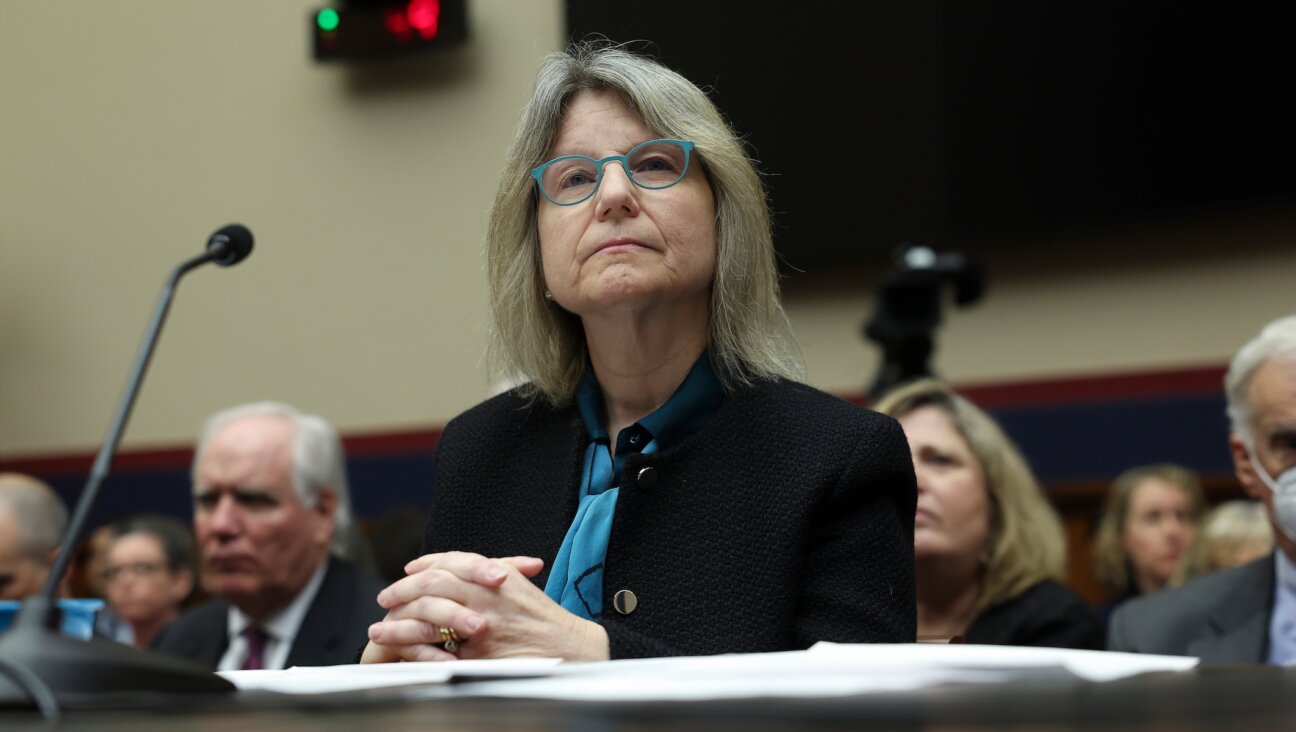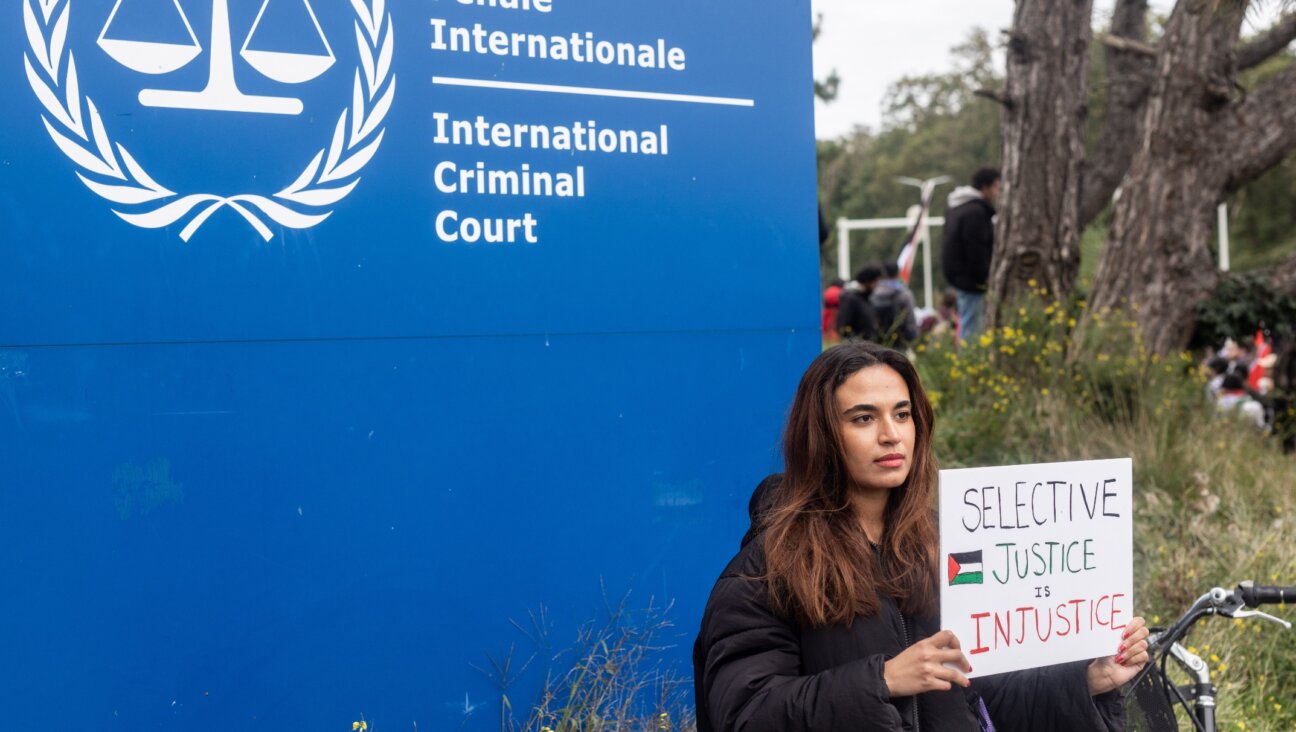This Great, Flawed Man Created A Jewish Boarding School — And Doomed It, Too

Graphic by Angelie Zaslavsky
Chico had a vision.
A wealthy aviation reinsurance magnate and a devoted Jew, Maurice “Chico” Sabbah took great pride in seeing the children of his Jewish community in Greensboro, North Carolina, become leaders of the faith. So he hatched a plan to make Greensboro — Jewish population, 3,000 — an international destination in elite Jewish education.
He poured over $100 million into his dream, buying 100 wooded acres and building a state-of-the-art campus, with hundreds of millions of dollars more planned for an endowment.
The school would be called the American Hebrew Academy — not, notably, the Sabbah Hebrew Academy. That mix of humility and ambition was Sabbah’s calling card.
“Chico’s style was to go big,” said Jonathan Krasner, a professor of Jewish education research at Brandeis University. “That’s why people took notice, and that’s why people also scratched their heads a little bit.”
But the tenacity and drive that had propelled Sabbah’s fortune into the hundreds of millions of dollars were ultimately not enough to secure AHA’s future: The school closed without warning earlier this month, saying it didn’t have enough revenue to cover its expenses. Indeed, the grandeur of “Chico’s dream,” as the school’s now-shuttered website called it, may have played a role in the school’s collapse. How did such a man who amassed a fortune come to leave his acumen behind when it came to his legacy project — and why couldn’t his successors pull the school out of a financial death spiral?
“This process is anguishing for everyone involved,” wrote Glenn Drew, the school’s CEO, and Leeor Sabbah, Chico Sabbah’s daughter and chair of the school’s board. “Some will be heartbroken. Others will feel anger but there is no one to blame.”
“It always helps to have a crazy person to get things started”
Born in 1929, Sabbah was raised in New York City by Zionist parents, and grew up wanting to be a farmer in Israel. He made aliyah after college, just after Israel had become a state, tilling soil on a kibbutz and serving in the Israeli military. He married an Israeli woman he met in the army, Zmira, and, after they moved back to the U.S., he served a tour of duty with the U.S. military during the Korean War.
Sabbah and Zmira and their two daughters eventually moved from New York to Greensboro, a historic Jewish community with a dynamism — and a dedicated local federation — that belies its small size. Sabbah was similarly of short stature yet strong from his farming days, a businessman who liked to talk brass tacks in his Long Island accent. He could be found nearly every Saturday sitting in the back of Beth David Synagogue, greeting the regulars and speaking Hebrew with Israelis in the community.
In 1979, Sabbah and a business partner bought the reinsurance agency they worked for, Fortress Re. They managed to pay off their debts in just three years; Sabbah’s family owned two-thirds of the company while his partner owned the rest. Starting in the 1970s and 1980s, Sabbah made inroads with large Japanese insurance firms, which paid Fortress hundreds of millions of dollars to manage their risk pools for commercial aircraft. Over the course of two decades, Sabbah’s net worth ballooned to the hundreds of millions of dollars.
“Dad was a dreamer, but he also had a very practical side and he believed that anything was achievable through hard work,” Leeor Sabbah said of her father in a 2012 promotional article. “When I was a kid, we were never allowed to say, ‘I can’t.’ He would firmly respond, ‘What do you mean, you can’t? You can do anything you put your mind to and work hard at.’”
With his newfound wealth, Sabbah became a dedicated patron of Beth David and Greensboro’s Jewish day school; his largesse landed him on Forbes’ list of 50 most philanthropic Americans several years in a row. Outwardly, however, he stayed humble: He never moved out of his modest ranch-style home on Friendly Avenue, just a few blocks from the synagogue. As of the early 2000s, he was still driving his 1973 Jaguar, which eventually accumulated over 250,000 miles.
Sabbah’s vision for AHA, however, was decidedly grand. It would be an international destination, would look like a prosperous boarding school on the level of Andover and Exeter and would compete with established liberal Jewish and Modern Orthodox academies around the country.
In the Jewish educational world, people were cautiously excited about the school’s potential. Sabbah had hired Rabbi Alvin Mars to be the first headmaster. Mars, a seasoned leader of Jewish educational programs and the former executive vice president of the Brandeis-Bardin Institute, was well-respected among Jewish educators.
“It seemed at the time that they were doing their homework, and it seemed like Mars had really thought this through,” said Krasner. “There was just a lot of optimism around this whole venture,” Krasner said.
Sabbah was self-aware about his singular role in getting AHA off the ground, and spoke frankly about it in a rare interview.
“We want others to participate, but it always helps to have a crazy person to get things started,” he told a reporter for Forbes in 2002.
Sabbah was so excited about his pet project that he went into it without a real spending cap in mind, said Freddy Robinson, a former treasurer for AHA’s board and former personal accountant for Sabbah. He paid over $10 million for the land, and then spent another $100 million on the buildings and what was then the world’s largest geothermal energy system, which cooled and heated buildings using water from hundreds of feet underground. On the school’s website, it tied this green energy system, along with the design philosophy of the campus — by Frank Lloyd Wright protege Aaron Green — to Sabbah’s love of farming, nature and tikkun olam — repairing the world.
“We had estimates of what it was gonna cost to build the school,” Robinson said. But Sabbah didn’t pay much attention to them: “He was just gonna do whatever it took.”

The closed-loop geothermal energy system at AHA. Image by Courtesy of Hazon
Every student got a laptop; every classroom had a multimedia whiteboard. Representatives for the school told potential parents and the press that it would eventually have 800 students enrolled, with over 200 faculty members. Sabbah told Forbes that he was hoping to find other donors to help him finance what was then a $250 million construction plan, and would himself build up a $500 million endowment for the school.
Robinson summed up Sabbah’s strategy: “If you build it, they will come.”
“Everything is secure”
On September 10, 2001, the families of the first 77 students finished moving their kids in to the AHA campus, which was still under construction. The next morning, the school’s financial fate changed forever.
When the planes first hit the Twin Towers, AHA’s students and staff were in the auditorium for morning prayers. The school’s head of security, Berkley Blanks, quickly pulled Sabbah and Mars out of the room and told them what had happened.
Blanks said that when he told Sabbah about the planes, Sabbah looked “like he was lost.”
Between the companies Sabbah’s Fortress managed, the company was responsible for the insurance payouts on all four planes used in the 9/11 terrorist attacks. But when the Japanese companies tried to collect from Sabbah’s company, the money wasn’t there — Fortress had not bought enough reinsurance policies to pay out the billions of dollars expected from the Japanese insurance firms.
The Japanese firms either went bankrupt, sued Fortress, or both. One firm alleged that Sabbah and his partner had engaged in a “complex scheme involving improper accounting and deceptive financial reporting,” through which they had diverted Fortress funds to a sister company, and skimmed hundreds of millions of dollars from management fees paid to Fortress by the Japanese insurance firms. An arbitration panel of insurance experts tasked with deciding the case found Fortress guilty of fraud and deliberate financial mismanagement.
The lawsuits stunned the Greensboro community, both for the accusations against Sabbah and because for many, it was the first they learned of his immense wealth.
Sabbah tried to reassure the school that it was safe.
“I have the best lawyers in the country defending me,” Sabbah said of the lawsuits in 2003. “I think we will prevail. So everything is secure.”
Sabbah and his partner eventually agreed to a $400 million settlement, paid out from their personal funds. But one of the Japanese companies also sued AHA, claiming that the $100 million that Sabbah had already put towards the school were actually funds diverted from Fortress, and thus legally belonged to the Japanese firms. The school settled in 2005 for an undisclosed amount. Drew, who was then Fortress’ attorney, repeatedly denied that Sabbah’s company had done anything wrong.
“Landing the big whale”
After the settlement, Sabbah’s donations to the school more or less stopped, Robinson said.
“It essentially cut off his income stream,” Robinson said of the suits, adding that the legal imbroglio was “devastating” for Sabbah.
Meanwhile, the school started to bleed cash, whether because it had to pay off its settlement with the insurance companies or because executing on Sabbah’s vision was just that expensive.
The school had started with about $80 million in temporary cash investments and securities, according to the first tax filing available for the school, from 2001.
By its 2005 filing, that number had dwindled to about $18 million. By 2013 — the year the school took out its first major loan — its total number of cash savings and investments was about $2.2 million.
Sabbah died in 2006, at 77, after what his family described as a “long illness.” After he was gone, the school did its best to hew to the grandiose course he had set. But none of the many different strategies it tried to bring in significant revenue were successful.
All the while, AHA’s administration declined to cut back on program expenses like course offerings, athletics or trips to Israel for the junior class. They never ran “half a program,” said David Feder, who worked at AHA from 2009 to 2015 and served as co-dean of Jewish life.
“It always seemed like they would somehow be able to keep it going,” Feder said.
Drew began traveling extensively to meet with someone who could replace Sabbah as the main benefactor, in one case trying and failing to court Sheldon Adelson, said one former AHA faculty member who asked not to be named.
“Glenn liked to use the phrase, ‘landing the big whale,’” the person said.
No such savior emerged.
“A shot in the dark kind of strategy”
Sabbah identified himself with the school, and the school with Sabbah. One former student said that Sabbah was spoken about like a “saint,” even after enduring the 9/11 lawsuits. Every year after Sabbah’s death, on Tu B’Shvat, the Jewish holiday of trees, the school would plant a tree on the campus in his honor.
He had indeed created a high caliber institution where serious Jewish and secular learning took place. Multiple students who spoke to the Forward recalled engaging classes with dedicated teachers, on courses ranging from drama, to high level math and science, to the study of Kabbalah. Students made lasting friendships, grew into their Jewish identities and learned how to live as independent young adults.
The school’s financial problems would compound after Sabbah was gone, but already in its early years it was churning through educators and burning through cash. Mars left after the 2002-2003 school year. Despite its aspirations to be an elite, international beacon of Jewish education, the school was run like a “mom and pop shop,” as Feder called it, with executive control wielded by Glenn Drew, who in addition to being Sabbah’s former attorney was also his nephew by marriage, and Leeor Sabbah, who became chair of the board after her father’s death.
“The family would hire you, pay you quite a lot, and then not be satisfied,” said Jonathan Sarna, a professor of Jewish history at Brandeis University. “Nobody had job security.”
Lacking a major benefactor, the school undertook several efforts to bring in revenue, starting with intensive fundraising and ending with an unusual, large, high-interest loan.
Drew readily admitted that AHA depended on fundraising. AHA’s board had multiple major financiers, most prominent among them Michael Steinhardt, the billionaire financier, as well as experts in nonprofit fundraising like Jehuda Reinharz, the former president of Brandeis University, and Joel Fleishman, a leading expert on nonprofit governance. But in some years the school reported donations only in the hundreds of thousands of dollars. Multiple board members reached by the Forward, including Reinharz, declined to comment for this story. Steinhardt’s foundation and Fleishman did not respond to requests for comment.
“This is a knowledgeable board,” said Elizabeth Boris, a fellow at the Urban Institute and a founding director of the Institute’s Center on Nonprofits and Philanthropy. “If anybody could raise money, a prestigious board like this should be able to do it.”
Despite the board’s and Drew’s fundraising failures, it continued to grant Drew an unusually high salary: It rose from $250,000 in 2005 to $466,000 in 2017. In one year, when the school brought in several large grants, Drew received over $900,000 in compensation.
The median salary for heads of independent combined boarding and day schools nationally was $275,400 in 2018, according to Myra McGovern of the National Association of Independent Schools. Sarna, who has served on several Jewish nonprofit boards, noted that Drew’s salary is more in line with the chief executives of Jewish family philanthropic funds — which frequently have family members on the board — than a small Jewish secondary school.
Lacking philanthropic funding, the school began trying to recruit students from non-Jewish families from abroad, especially in China. The school hoped that these families could be relied upon to pay full tuition. But their efforts, begun in earnest over the past year, only resulted in two Chinese students being enrolled for the 2019-2020 semester.
The school then took out loans. In 2015, it borrowed $25 million from Titan Capital, a bridge lending firm that specializes in commercial real estate loans. Bridge loans, often used in real estate development, are short term loans with high interest rates, often between 9% and 11%. On its website, Titan says that its lending terms run up to three years.
The loan was described to AHA staff as a way to buy the school some time as they explored recruiting strategies in China and elsewhere around the world, the former faculty member said. According to public North Carolina property records, the loan has not been paid off.
It’s increasingly common for colleges and universities to rely on their land and buildings as collateral for short term loans, said James Hearn, a professor of education at the University of Georgia.
But it’s not clear why the school would seek a bridge loan if it were not planning to buy more land or build new facilities, the most common uses for this kind of loan in commercial or institutional contexts, McGovern said.
“It sounds to me like it was a real kind of shot in the dark kind of strategy,” Krasner said. “This is a school that wasn’t able to fill its dormitories, this is a school that was perennially below target in terms of enrollment.”
“Sudden, abrupt and beyond terse”
On the morning of June 11, Glenn Drew called his annual end-of-year meeting. Staff members not yet on vacation were had already been in the office for a couple hours. Some were working on the foreign student recruitment strategies. Within seconds of opening the meeting, Drew had announced AHA’s closing. By the time he walked out the door a few moments later, many faculty members were in tears. The news quickly filtered out into a stunned Greensboro Jewish community. The former AHA administrator called the announcement “sudden, abrupt and beyond terse.”
“Everyone was quite shocked by the news,” said Marilyn Chandler, the executive director of the Greensboro Jewish Federation. “Part of our family was cut off,” she said.
Now 100 students are without a school, less than three months before the beginning of the next school year, and close to 100 employees, including about 40 teachers, are without jobs.
In response to the closure, the Jewish Family Services of Greensboro is offering financial assistance, counseling and career consulting to former AHA staff. They are also accepting donations to go towards supporting former AHA staff. So far, they have raised over $20,000, Chandler said.
“For now our responsibilities and priorities are to focus on and assist our former employees, students and families in their transition to other schools as expeditiously as possible,” Drew said in an email to the Forward Friday morning. Both Drew and Sabbah have declined multiple requests to comment further.
What remains of the school is a lush campus with a bust of Chico Sabbah, overlooking a garden planted with trees and bushes indigenous to the land of Israel, and Sabbah’s unfulfilled vision for an elite, pluralistic Jewish boarding school.
On the slab of Jerusalem stone supporting Sabbah’s bust, an epitaph from Pirkei Avot has been inscribed: “…loves God, loves all creation, loves charitable deeds… shuns honor.”
Ari Feldman is a staff writer at the Forward. Contact him at [email protected] or follow him on Twitter @aefeldman

















